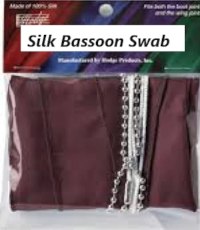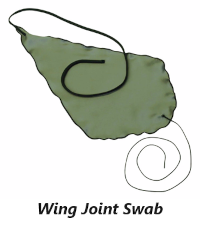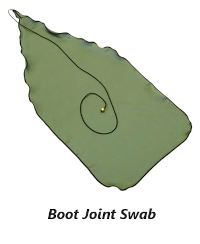The Purpose of Swabbing
The bassoon needs to be swabbed after every time it is played.
The purpose of swabbing is to dry out the inside of an instrument. The bassoon needs to be swabbed after every time it is played. In addition to drying out the bore (the hollow tube that runs down the center of the instrument), swabbing protects the pads from damage from staying wet. A fabric pull-through bassoon swab is the kind I recommend.
Swabbing the Boot and Wing Joints
The boot joint and the wing joint are the only two joints that need to be swabbed. Water should never reach the long joint or the bell, so they don’t need to be swabbed.
Swabs
Use a cloth drop swab made especially for the bassoon.
NEVER USE those fuzzy stick swabs that look like saxophone swabs. They only add lint and crud to the bore. Throw them away!

*Some older bassoons might have a stick swab that is covered with cloth. These will work for the boot joint but not the wing joint. The drop-type swabs do a more thorough job of drying the bore.
Swab Sizes:
One Size Fits All: The Hodge Silk Bassoon Swab can be used in both the boot joint and the wing joint. It is made of just the right size piece of silk fabric that crushes easily so it can easily slide through the wing joint. You can also flatten this silk swab out a bit and it will be large enough to use in the boot joint. This swab has a string attached to a piece of chain (no weight or brass ball) so it can go through the wing and the boot.

Or you can use a set of two swabs, each specific to a particular joint.
Wing joint swab (cotton, microfiber, or silk) These usually have a 1-inch fabric-covered weight at the end of the string.

Boot joint swab (cotton, microfiber, or silk). The best ones have a length of chain attached to the end of the string for easy passage through the u-bend of the boot.

I prefer option #1 (one size fits all) for students and schools because you don’t have to worry about getting the boot swab stuck in the wing. The silk compresses to allow easy passage through the wing and expands to adequately clean the boot. Silk swabs can easily be hand-washed with soap and warm water and will dry quickly.
How to Swab:
To Swab the Boot:
- Check the full length of the swab for knots and remove any you find.
- Hold the boot with the bore holes facing up and the open holes facing you.
- Feed the string of the boot joint swab into the LARGE bore hole (the one for the long joint – it is unlined).
- Feed in as much of the string and swab as possible.
- Tilt the boot joint to the left and shake while turning the boot so that the cap faces up. Keep the open holes facing you as you turn the boot. (You are guiding the swab down the large hole and around the u-bend so that it will come out the other side of the boot.
- The swab should come out the small hole at the top of the boot joint once the bore holes are facing down and the cap is facing up. If not – shake the bassoon gently until the end of the swab comes through. If shaking doesn’t work, or if the swab falls out the large hole – start over and try again.
- Repeat 2 or 3 times.
To Swab the Wing:
- Check the full length of the swab to make sure there are NO KNOTS in the string or the fabric. Remove any knots that you find BEFORE putting the swab into the wing joint or it will get stuck.
- Hold the wing joint upside down (with the tenon end up) and feed the weighted end of the string into the wing joint tenon until it comes out the other end (down by the whisper-key pad.
- Catch the weighted string or chain at the whisper-key pad end of the wing and pull it through the wing joint until the complete swab has passed through the wing joint.
- Repeat two or three times until the bore is dry. You can check the bore by holding it up to a light source and looking through the bore in the direction of the light.
STOP immediately if you feel resistance! Continuing to pull in the same direction will only make the problem worse.
Instead, grasp the tail of the fabric and pull in the opposite direction so the swab comes out the same end where it entered the wing joint.

Feedback/Errata